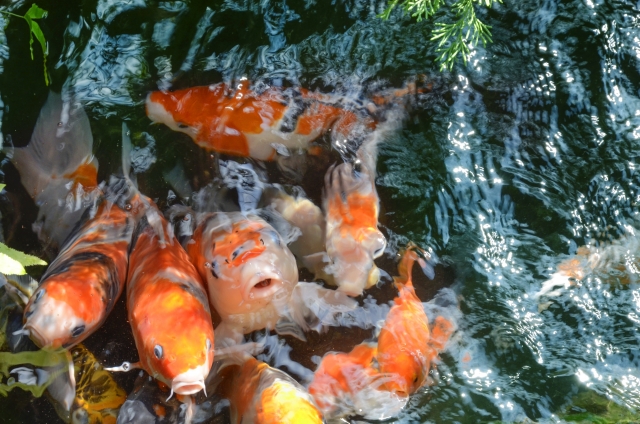In the season of young leaves, so radiant and miraculous as if new born life, we went to Matsue Castle in Shimane prefecture and climbed up to the top. Matsue Castle is designated as the National Treasure. One thought that always occurs in mind whenever visiting old castles or the Courts in and out of Japan is that “Prideful man is not lasting forever, just like a spring night dream.”
新緑の若葉が生まれたての生命の様に、まるで奇跡の様に美しい季節に、国宝に指定されている島根の松江城に登閣してきた。つまりは、其の天守閣へと登ってきた。日本国内の城巡りをしたり、海外の古城や宮廷を訪れる度に胸に去来する一つの思い、それは「おごれる人も久しからず、ただ春の夜の夢の如し」という無常観だ。
Everything is evanescent and transient. I’m not certain if this point of view is acquired as a result of learning through education, or carved in genes as Japanese that finds beauty in perishing, or both. But one thing is undoubted that people love visiting historical remains and finely picking up particles of memories of the history engraved so deeply. And giving own interpretation is highly amusing.
これは教育を通して後天的に学んだ物の見方なのか、滅びの美に浪漫を感じる日本人としての血なのか、或いは其のどちらともなのかは分からない。けれど歴史が刻みつけた記憶の欠片を、自分の足を直に運んで丹念に拾い集め、自分なりの解釈を講じてみることは、多くの人が好むところである。



Matsue Castle was completed building in 1611 after Tokugawa Ieyasu succeeded of unification of the whole country after the Battle of Sekigahara in 1600. It’s been remodeled countless times until now, but the castle tower has been remained the same since the beginning. It is evident that many of old castles in Japan have a shrine in the premises. It is enshrined to protect the castle and the country.
松江城は徳川家康の天下統一関ヶ原の戦い(1600) の後、1611年に完成した。その後なんども改築されて現在に至るが、天守は創建当初の姿を残している。国内の城めぐりをすると気づくことがあるが、神社が城と一緒の敷地に建てられていることが多い。これは城と国の守護のために祀られているためだ。

Taking off shoes and climbed up 6-story castle that is led by steep stairs. Stood on a board and saw through the bottom and felt a bit scary since there is nothing more than 10 meters below.
靴を脱ぎ、急な階段が続く六階建の城を登る。板一枚の上に立ち、裂け目を覗き込む。下は十メートル以上あると思うと、少し怖くなる。


A map of Edo period (1603~1867) marking every castle all across Japan. In those days, Hokkaido was called Ezo and was not developed. Counted each castle that I’ve visited. Aizuwakamatsu Castle in Fukushima, Mito Castle and Mito Kairakuen of Ibaragi, Edo Castle Remains of Tokyo (present Emperor’s Palace), Nagoya Castle of Aichi, Hagi Castle Remains of Yamaguchi, Kochi Castle of Kochi, Maizuru Castle Remains and Kokura Castle and Akizuki Castle Remains of Fukuoka, Karatsu Castle of Nagasaki, Kumamoto Castle of Kumamoto, and this Matsue Castle of Shimane. Visiting castles is so enchanting. Exploring history is filled with poetic sentiment, and indulging in the blissful moment is one of a kind.
江戸時代(1603〜1867) にあった全国の城の場所が記された地図。北海道は当時は蝦夷(えぞ)と呼ばれ、開拓されていなかった。これまでにどの城に行ったことがあるかを数えてみたら、福島の会津若松城、茨城の水戸城および水戸偕楽園、東京の江戸城跡(現皇居)、愛知の名古屋城、山口の萩城跡、高知の高知城、福岡の舞鶴城跡、及び小倉城、及び秋月城跡、長崎の唐津城、熊本の熊本城、そしてここ島根の松江城となる。城めぐりは、多くの人が好む行楽である。歴史探訪という、浪漫と叙情に耽る喜び。
From here, dropping down rocks to protect the castle when enemies’ attack. And the watch window, and the drum for letting know of time.
敵が攻め入ってきた時に石を落として防御する石落とし、見張り窓、刻 (とき) を知らせた太鼓。



The most impressive thing in this Matsue Castle was Samurai warrior’s helmet and body protector that was actually used for battles. Sensed some kind of spirit was still there. It was wrapped with unearthly atmosphere. Supposedly, the samurai’s DNA is still there. Slightly felt shivering.
そして、この松江城にて最も印象深かったのは、侍が実際に身につけて戦を交えた甲冑である。其の霊が今もそこに留まっているかの様な、鬼気迫るものを感じる。恐らく、未だに其のDNAは刻み付けられたままだと思われて、少し身震いがする。

Matsue Catle was once demolished in 1877 after obeying the abandoning order. But it was revitalized after countless remodeling.
松江城は廃城令により1877年に一度取り壊されたものの、その後多くの改築を経て、再び其の息を吹き返した。
Taking good amount of time and reached to the top. You can see through the city of Matsue.
そして、天守閣へようやく登頂。松江の街が一望出来る。


Japanese culture is strongly influenced by China, and it is especially prominent in the classical literature. Here I want to write down poems and phrases that draw near to hearts of Japanese when visiting old castles.
日本文化は中国の影響を色濃く受けており、古典文学の面では其の傾向は顕著である。そして、古城巡りをする度に多くの日本人の心に迫り来ると思われる詩句を、ここで書いてみたい。
A poem of Toho (712〜770) of China in the Tang dynasty, the beginning part.
中国の唐代の詩人、杜甫(712〜770) が書いた漢詩の冒頭。
『春望』
国破山河在
城春草木深
感時花濺涙
恨別鳥驚心
“Shunbou, waiting for spring”
Mountains and rivers remains after the country was lost
The castle is filled with grasses and trees in the spring
Captured in the time and tears for flowers
Resenting parting and astonished even by birds
『春望』
国破れて山河あり
城春にして草木深し
時に感じては花にも涙をそそぎ
別れを恨んでは鳥にも心を驚かす
Kamono Choumei (1155?〜1216) wrote an essay of “Houjouki” in seclusion from the world starts like this.
また、鴨長明(1155?〜1216)が遁世して書いた、無常感の漂う『方丈記』はこう語る。
“Houjouki”
The flow of river never ends and the water is not the same. Floating water bubbles are in and out, never stay the same.
『方丈記』
行く川のながれは絶えずして、しかも本の水にあらず。よどみに浮かぶうたかたは、かつ消えかつ結びて久しくとどまることなし。
And “Heike Monogatari” dealing battles of Heike and Genji during 1180〜1185. It was originally a story-telling art of blind Biwa Houshi monks that wandered around the country and played Biwa guitar-like instrument while telling and singing the story.
そして、1180年〜1185年に起こった源氏と平家の戦、源平合戦の様を物語った『平家物語』の冒頭はこう始まる。これは元々語り芸であり、盲目の琵琶法師が琵琶を担ぎ、各地を放浪しながら語り歌っていたもの。
“Heike Monogatari”
The bells of Gionshouja, the sounds and echos telling nothing is eternal. The color of Sarasoujyu, represents the truth of mighty men are sure to perish. Prideful man is not lasting forever, just like a spring night dream.
『平家物語』
祇園精舎の鐘の声、諸行無常の響きあり。沙羅双樹の花の色、盛者必衰の理をあらはす。おごれる人も久しからず、ただ春の夜の夢のごとし。
And time descended and Matsuo Basho (1644〜1694) made a Haikai (Haiku poem)
そして時が下り、江戸時代の松尾芭蕉(1644~1694) が詠んだ俳諧
Summer grasses
The remains of the Dreams
Of the warriors
夏草や
兵(つわもの)どもが
夢の跡
Restudied the content above that learned in the classes of Japanese, Classical Japanese Literature, and Classical Chinese Literature in junior high and high school. Something deep struck me and I pondered over. The never ending ambition of conquest and unification of the country, and the mighty drive for the realization, and the eternal truth on the back that everything is evanescent and transient just like water bubbles that flow and never stay the same. Cant’t help but contemplate the universal truth of the history. Wonder if the life is ephemeral and fleeting just like a spring night dream?
中学高校の国語、古典、漢文の授業で習った内容を、もう一度学び直し、しみじみとした感慨に浸る。いつの時代にも変わらずあった「天下統一」という果て無き野望と、その実現の為に激しくつき動かされる心と、また其の反面の真理でもある、すべては流れ行き留まることはない、うたかたの様なものであるという無常観。人間というもの、歴史というものが等しく宿す普遍性に、思いを馳せずにはいられない。はたして人生は、すべて春の夜の夢のごとく儚いものであるのだろうか。

参考文献:「松江城」石井悠、ハーベスト出版、2015
「漢詩の名句・名吟」村上哲見、株式会社講談社、講談社現代新書、1990
「日本の芸術史 文学上演篇Ⅰ 歌、舞、物語の豊かな世界」矢内賢二編、藝術学舎、2014






















